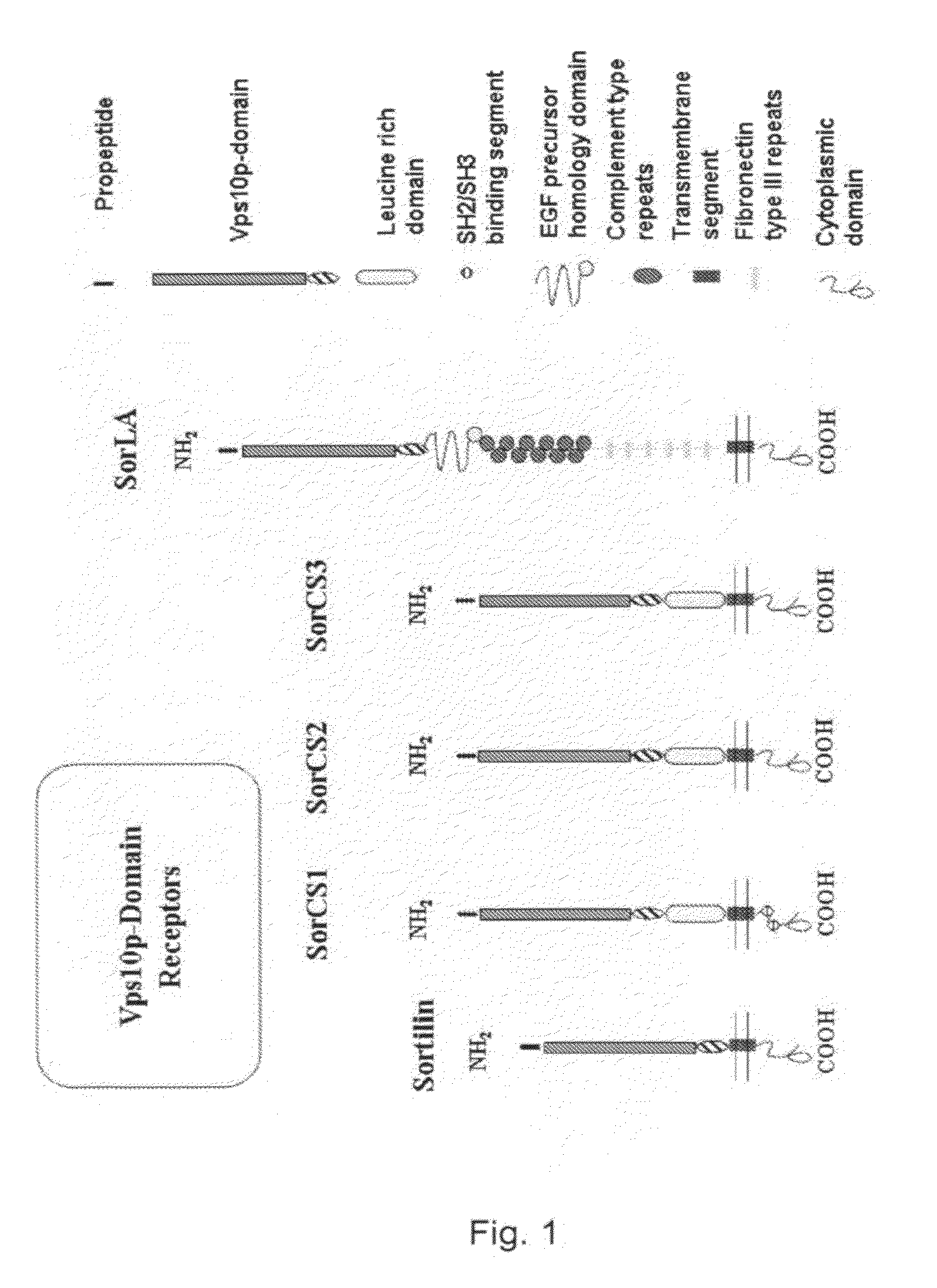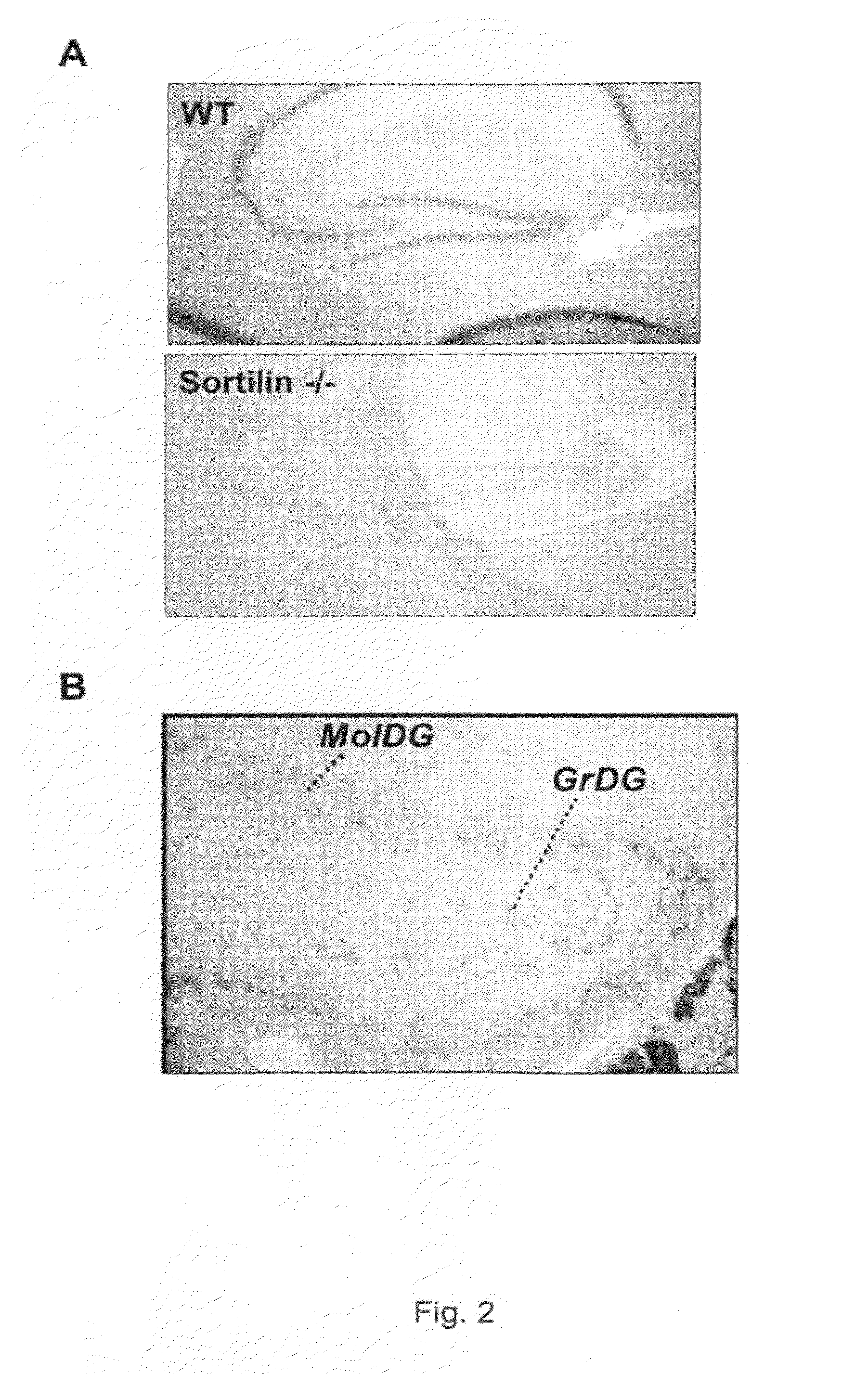Modulation of the vps10p-domain receptor family for the treatment of mental and behavioural disorders
a technology of vps10p and receptors, applied in the field of vps10pdomain receptors, can solve the problems of difficult treatment, severe mental and behavioural symptoms, and chronic, often life-threatening illnesses
- Summary
- Abstract
- Description
- Claims
- Application Information
AI Technical Summary
Benefits of technology
Problems solved by technology
Method used
Image
Examples
example 1
Demonstration of a SorCS2:p75NTR Complex
[0945]HEK293 cells stably transfected with plasmids encoding SorCS2 and p75NTR were crosslinked with DSP (Pierce) and subsequently lysed. The cell lysate was incubated with antibody against SorCS2 bound to Gammabind beads (GE Healthcare). Precipitated complexes were eluted from the washed beads with SDS loading buffer. Western blot analysis revealed the presence of a SorCS2: p75NTR complex (FIG. 6A). The direct interaction of the extracellular domains of SorCS2 and p75NTR was also demonstrated using surface plasmon resonance (Biacore, Sweden) using CaHBS as standard running buffer (10 mM HEPES, pH 7.4, 140 mM NaCl, 2 mM CaCl2, 1 mM EGTA, 0.005% Tween-20). A biosensor chip from Biacore (CM5, cat.no. BR-1000-14) was activated using the NHS / EDC method as described by the supplier followed by coating with SorCS2 (FIG. 6B).
example 2
Demonstration of a SorCS2:TrkB Complex
[0946]The direct interaction of the extracellular domains of SorCS2 and TrkB was demonstrated using surface plasmon resonance (Biacore, Sweden) using CaHBS as standard running buffer (10 mM HEPES, pH 7.4, 140 mM NaCl, 2 mM CaCl2, 1 mM EGTA, 0.005% Tween-20). A biosensor chip from Biacore (CM5, cat.no. BR-1000-14) was activated using the NHS / EDC method as described by the supplier followed by coating with SorCS2 (FIG. 15C). The SorCS2:TrkB complex is also demonstrated by co-immunoprecipitation. Cells expressing SorCS2 and TrkB, e.g. following transfection with plasmids encoding both receptors, respectively, are crosslinked with DSP (Pierce) and subsequently lysed. The cell lysate is incubated with antibody against SorCS2 bound to Gammabind beads (GE Healthcare). Precitated complexes are eluted from the washed beads with SDS loading buffer. Western blot analysis reveals the presence of a SorCS2:TrkB complex.
example 3
Demonstration of the Interaction of SorCS2 with the BDNF Propeptide and with Mature BDNF
[0947]The direct interaction of the extracellular domain of SorCS2 and with the BDNF propeptide and with mature BDNF was demonstrated using surface plasmon resonance (Biacore, Sweden) using CaHBS as standard running buffer (10 mM HEPES, pH 7.4, 140 mM NaCl, 2 mM CaCl2, 1 mM EGTA, 0.005% Tween-20). A biosensor chip from Biacore (CM5, cat.no. BR-1000-14) was activated using the NHS / EDC method as described by the supplier followed by coating with SorCS2 (FIG. 7).
PUM
| Property | Measurement | Unit |
|---|---|---|
| weight percent | aaaaa | aaaaa |
| weight percent | aaaaa | aaaaa |
| weight percent | aaaaa | aaaaa |
Abstract
Description
Claims
Application Information
 Login to View More
Login to View More - R&D
- Intellectual Property
- Life Sciences
- Materials
- Tech Scout
- Unparalleled Data Quality
- Higher Quality Content
- 60% Fewer Hallucinations
Browse by: Latest US Patents, China's latest patents, Technical Efficacy Thesaurus, Application Domain, Technology Topic, Popular Technical Reports.
© 2025 PatSnap. All rights reserved.Legal|Privacy policy|Modern Slavery Act Transparency Statement|Sitemap|About US| Contact US: help@patsnap.com



